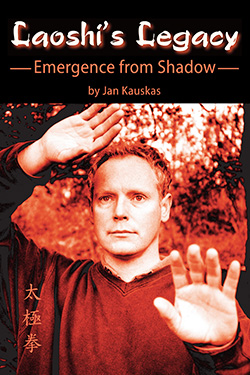Let me begin this review by disclosing that I hadn’t read the author’s first book, “Laoshi: Tai Chi, Teachers, and Pursuit of Principle,” until asked by the publisher to pen a review for this second volume. I thought it would be prudent to read Laoshi first as the publisher had informed me that Laoshi’s Legacy is, as the title suggests, something of a sequel to the earlier volume. It was auspicious then that I found Laoshi thoroughly engaging and full of valuable tidbits, both philosophical and technical. I liked Jan Kauskas’ writing style as immediately intimate and process-oriented. I felt cast as a fly on the wall during his reconstructed conversations with and about his various teachers and their teachers. All this served as an ideal backdrop as I prepared myself for a go through Laoshi’s Legacy.
 One of the challenges writers face in putting out a second book on the heels of a very good first book is meeting readers’ now-high expectations. Throughout this second volume, and in like manner to his earlier book, the author continues to capture and portray the realities of student/teacher scenarios and dynamics by casting himself as the student struggling to reconcile his own insecurities and developing perspectives with the wisdom and seeming idiosyncrasies of his teacher, the sagacious Laoshi.
One of the challenges writers face in putting out a second book on the heels of a very good first book is meeting readers’ now-high expectations. Throughout this second volume, and in like manner to his earlier book, the author continues to capture and portray the realities of student/teacher scenarios and dynamics by casting himself as the student struggling to reconcile his own insecurities and developing perspectives with the wisdom and seeming idiosyncrasies of his teacher, the sagacious Laoshi.
This book does not disappoint in follow-up to Laoshi as provocative and insightful lesson after lesson greets the reader. Highlighted early on is the lesson that while there is something to be said for submitting ourselves to the discipline of taijiquan, doing so blindly or without regard for pre-existing injuries or limitations may produce more harm than good. Also early on, the author offers important tempering words as regards the tendency of many practitioners to imbue taijiquan with fantastical expectations. The many diverse topics that follow remain similarly engaging right through to the final pages.
As a school owner/operator myself for over fifty years, I was particularly impressed by the candid and revealing manner in which the author dealt with the seeming discrepancies involved in balancing a “spiritual” enterprise with the realities and accountabilities of running a successful business, and of how to reconcile the moral ambiguities implicit in a study of taijiquan and pursuit of Dao with the distractions and allure of modern life in a high tech world. How to strike a balance?
Throughout this book the author cleverly and convincingly speaks in two voices, as the insecure and naive student-narrator evolving along his own path in his own time, and as the wise and knowledgeable Laoshi guiding the student in his development. Of course, Kauskas could only write as he does having already achieved a level of knowledge, skill, and wisdom well beyond that portrayed by his student character.
Though the book is not written as a technical instruction guide, there are quite a few passages that speak directly to technical aspects of taijiquan form or push-hands practice from which the knowledgeable reader will be able to glean practical advice.
In summary, Laoshi’s Legacy is a must-read book for all serious taijiquan students and teachers.

Leave a Reply